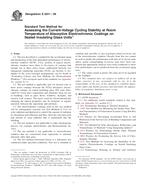Potřebujeme váš souhlas k využití jednotlivých dat, aby se vám mimo jiné mohly ukazovat informace týkající se vašich zájmů. Souhlas udělíte kliknutím na tlačítko „OK“.
ASTM E2241-06
Standard Test Method for Assessing the Current-Voltage Cycling Stability at Room Temperature of Absorptive Electrochromic Coatings on Sealed Insulating Glass Units (Withdrawn 2015)
Automaticky přeložený název:
Standardní zkušební metoda pro posouzení současného napětí Cyklistika stability při pokojové teplotě absorpčního elektrochromního povlaků na uzavřených izolačních skel (Withdrawn 2015 )
NORMA vydána dne 1.9.2006
Informace o normě:
Označení normy: ASTM E2241-06
Poznámka: NEPLATNÁ
Datum vydání normy: 1.9.2006
Kód zboží: NS-44767
Počet stran: 10
Přibližná hmotnost: 30 g (0.07 liber)
Země: Americká technická norma
Kategorie: Technické normy ASTM
Anotace textu normy ASTM E2241-06 :
Keywords:
chromogenic glazing, durability, electrochromic windows, fenestration, fenestration products, ICS Number Code 81.040.30 (Glass products)
Doplňující informace
| Significance and Use | ||||||||||||||||||
|
This test method is intended to provide a means for evaluating the current-voltage cycling stability at ca. 22°C of ECWs as described in 1.2.2 ,4 (See Appendix X1, sections X1.4-X1.7.) |
||||||||||||||||||
| 1. Scope | ||||||||||||||||||
|
1.1 The test described is a method for the accelerated aging and monitoring of the time-dependent performance of electrochromic windows (ECW). Cross sections of typical electrochromic windows have three to five-layers of coatings that include one to three active layers sandwiched between two transparent conducting electrodes (TCEs, see Section ). Examples of the cross-sectional arrangements can be found in "Evaluation Criteria and Test Methods for Electrochromic Windows." (For acronyms used in this standard, see , section ). 1.2 The test method is applicable only for layered (one or more active coatings between the TCEs) absorptive electrochromic coatings on sealed insulating glass (IG) units fabricated for vision glass (superstrate and substrate) areas for use in buildings, such as glass doors, windows, skylights, and exterior wall systems. The layers used for electrochromically changing the optical properties may be inorganic or organic materials between the superstrate and substrate. 1.3 The electrochromic coatings used in this test method will be subsequently exposed (see Test Methods E 2141) to solar radiation and deployed to control the amount of radiation by absorption and reflection and thus, limit the solar heat gain and amount of solar radiation that is transmitted into the building. 1.4 The test method is not applicable to other chromogenic devices, for example, photochromic and thermochromic devices. 1.5 The test method is not applicable to electrochromic windows that are constructed from superstrate or substrate materials other than glass. 1.6 The test method referenced herein is a laboratory test conducted under specified conditions. This test is intended to simulate and, possibly, to also accelerate actual in-service use of the electrochromic windows. Results from this test cannot be used to predict the performance with time of in-service units unless actual corresponding in-service tests have been conducted and appropriate analyses have been conducted to show how performance can be predicted from the accelerated aging tests. 1.7 The values stated in metric (SI) units are to be regarded as the standard. This standard does not purport to address all of the safety concerns, if any, associated with its use. It is the responsibility of the user of this standard to establish appropriate safety and health practices and determine the applicability of regulatory limitations prior to use. |
||||||||||||||||||
| 2. Referenced Documents | ||||||||||||||||||
|
Odebírejte informace o nově vydaných normách ZDARMA:
Chcete pravidelně odebírat informace o nově vycházejících normách z celého světa a to zcela zdarma?
Přihlašte se k odběru. Vše je velice jednoduché a absolutně ZDARMA.
Na výběr máte vydavatele z celého světa.




 Cookies
Cookies
